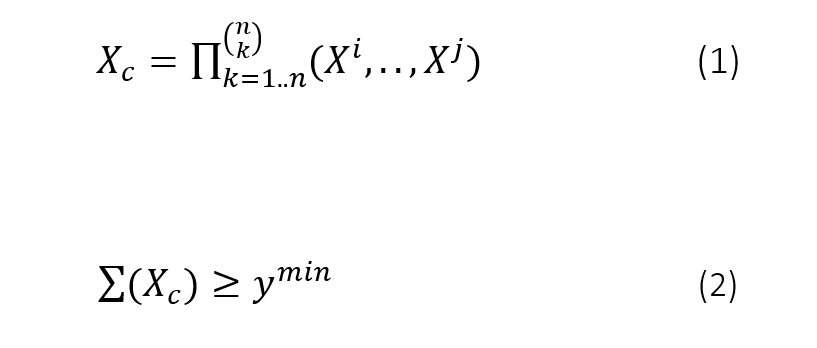Pre-processing
To detect significant edge probabilities between pairs of vertices (node-links) given a data set, hnet consists a multi-step process that are described below.
Typing
The first step is pre-processing the data set by feature typing. In this step we type each feature as categoric, numeric or is excluded. The typing can be user-defined or automatically determined on conditions. In the latter case, features are set to numerical if values are floating type or have more than a minimum number of unique elements (e.g., if the number of unique elements >20% of the total non-missing). Features are set to categoric if values are boolean, integer or string.
One-hot Enconding
The second step is encoding the categoric values into a one-hot dense array. This is done using df2onehot. The one-hot dense array is subsequently used to create combinatory features using k combinations over n features (without replacement, Figure 1C). The default k is set to 1, meaning that the input matrix (Xcategoric) is the same as combinatory matrix (Xcombination). When k>1, n boolean features are combined by multiplication for k unique combinations (eq.1). Each new combinatoric feature (Xc) is then added to the dense array.
Statistical inference
Each feature is examined on enrichment compared to another in the function hnet.hnet.enrichment(). To avoid high computational costs, mutual exclusive features are excluded, and features are excluded in case Xi contains less then ymin positive samples (default ymin=10, eq.2).
Hypergeometric test
To assess significance with the categoric features (Xcategoric), the final dense array is tested for over-representation of successes in sample Xi by means of the hypergeometric distribution. The hypergeometric P-value between feature Xi and feature Xcj, is calculated as the probability of randomly drawing x or more successes from the population in n total draws with population size N containing K successes. For any Xi and Xcj, Pc(i,j) is computed as depicted in eq.3.
Wilcoxon Ranksum
To assess significance across the numeric features (Xnumeric) in relation to the dense array (Xcombination) we utilized the Mann-Whitney-U test. Each numeric vector Xni, is split on categoric feature Xci versus ~Xci, and tested whether randomly selected value from Xci will be less than or greater than a randomly selected value from ~Xci.
Multiple testing
All tested edge probabilities between pairs of vertices, either categoric-categoric or categoric-numeric, are stored in an adjacency matrix (Padj), and are corrected for multiple testing. The default Multiple Test Method (MTM) is set to Holm20 (Figure 1, equation 4) but optional are various other False Discovery Rate (FDR)18 or Familywise error rate (FWER)19 methods.
The last step in HNet (Figure 1F) is declaring significance for node-links. An edge is called significant under alpha is 0.05 by default. The edge-weight is computed as depicted in equation 5.
The final output of HNet is an adjacency matrix containing edge weights that depicts the strength of pairs of vertices. The adjacency matrix can then be examined as a network representation using d3graph.
Enrichment
An example of calculating hte enrichment is demonstrated below for a single response variable.
import hnet
# Example dataset
df = hn.import_example('titanic')
# Set response variable y
y = df['Survived'].values
# Compute enrichment for input dataset df and y
out = hnet.enrichment(df, y)
# [HNET] Start making fit..
#
# [DTYPES] Auto detecting dtypes
# [DTYPES] [PassengerId] > [int] ->[cat] [891]
# [DTYPES] [Survived] > [int] ->[cat] [2]
# [DTYPES] [Pclass] > [int] ->[cat] [3]
# [DTYPES] [Name] > [obj] ->[cat] [891]
# [DTYPES] [Sex] > [obj] ->[cat] [2]
# [DTYPES] [Age] > [float]->[num] [88]
# [DTYPES] [SibSp] > [int] ->[cat] [7]
# [DTYPES] [Parch] > [int] ->[cat] [7]
# [DTYPES] [Ticket] > [obj] ->[cat] [681]
# [DTYPES] [Fare] > [float]->[num] [248]
# [DTYPES] [Cabin] > [obj] ->[cat] [147]
# [DTYPES] [Embarked] > [obj] ->[cat] [3]
# [DTYPES] Setting dtypes in dataframe
#
# [HNET] Analyzing [cat] PassengerId.
# [HNET] Analyzing [cat] Survived.
# [HNET] Analyzing [cat] Pclass.
# [HNET] Analyzing [cat] Name.
# [HNET] Analyzing [cat] Sex.
# [HNET] Analyzing [num] Age.
# [HNET] Analyzing [cat] SibSp.
# [HNET] Analyzing [cat] Parch.
# [HNET] Analyzing [cat] Ticket.
# [HNET] Analyzing [num] Fare.
# [HNET] Analyzing [cat] Cabin.
# [HNET] Analyzing [cat] Embarked.
# [HNET] Multiple test correction using holm
# [HNET] Fin
The output is a dataframe for which each row describes the feature and the columns the statistics belonging to it. By default, only significant features, i.e., alpha<0.05 after multiple test correction are kept in the output.

As can been seen from the results, the most significant feature is Survived as shown in the category_name and P value. This is as expected as we used this variable as the response variable. The description of the output variables can be found here: hnet.hnet.enrichment()
black/white listing
Input variables (column names) can be black or white listed in the model. When variables are black listed, they are excluded from the search and the resulting model will not contain any of those edges. If variables are white listed, the search is limited to only those edges. The resulting model will then only contain edges that are in white_list.
White listing
from hnet import hnet
hn = hnet(white_list=['Survived', 'Pclass', 'Age', 'SibSp'])
# Load data
df = hn.import_example('titanic')
# Association learning
out = hn.association_learning(df)
Black listing
from hnet import hnet
hn = hnet(black_list=['Survived', 'Pclass', 'Age', 'SibSp'])
# Load data
df = hn.import_example('titanic')
# Association learning
out = hn.association_learning(df)
Four methods of filtering are possible in hnet
black_list : Excluded nodes form the plot. The resulting plot will not contain this node(s).
white_list : Only included the listed nodes in the plot. The resulting plot will be limited to the specified node(s).
threshold : Associations (edges) are filtered based on the -log10(P) > threshold. threshold should range between 0 and maximum value of -log10(P).
min_edges : Nodes are only shown if it contains at least a minimum number of edges.



